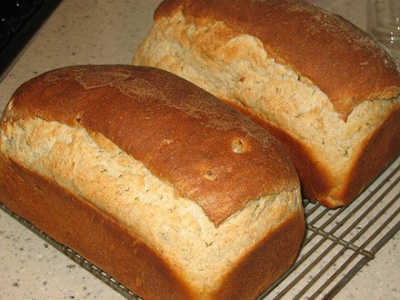Sourdough Bagels
 bagels
bagels
 bagels
bagels
I made some sourdough bagels this morning. I used Bwraith's post, which was based on Susanfnp's post, as a guide: Sourdough Bagels Revisited. These were based on Silverton's recipe from _Breads from the La Brea Bakery_. After going back and forth reading Silverton's recipe and the modified ones, I decided to go with Bwraith's post exactly, well as exactly as I could. I made some slip-ups, which really affected my bagels. They taste great, but they are pretty open and bready and they puffed a little too much. I know precisely what my mistakes were and I thought I'd post them for others who might do some bagel making. All that I did wrong were small errors on my part, things like not taking notice of details in the write up and such. Anyhoo, here gos:
The write up called for 90% hydration starter. In my tendency to over look random details I refreshed my starter at 100%. I believe this is why they were bready. The idea of the dough having a slightly higher hydration was already blamed for breadiness in the discussions between Bwraith and Susanfnp and Bwraith discussed it throughout the comments, but it still went right out the other ear, since it was a difference in the starter.
I shaped some of them using the rope method used in the post and I shaped some of them using a method discussed in BBA where you make a roll and then poke a hole in it and twirl it around your finger. I think I like the rope method better, they were more consistently smooth. My mistake here though was I didn't make the center hole big enough and many of them closed up. Again, something discussed in the post, but I wasn't careful to take notice of it. They should have been about 2.5 inches and mine were only about 1.5 inches.
I believe I worked pretty quickly in getting them into the fridge after shaping and in going through the whole boiling baking process, but they still puffed too much. I think I'll blame this on the fact that my kitchen was 68 degrees and steamy. In fact my whole tiny apartment was steamy because of the big pot of boiling water. Next time I'll open the double doors next to my kitchen and let the chilly morning air in. I'm pretty sure the warm stuffiness of my kitchen gave them a good proofing environment for the four minutes that they sat out between the fridge and the oven.
I think that small slip-ups like these can be so easy to come across and I hope that discussing them will help them sink in more, making them easier to avoid in the future.
Now on to the good things:
I used 5% Giusto light rye flour, 15% Giusto whole wheat flour and 80% KA High Gluten flour, which all worked out great. They really taste quite awesome.
I used poppy seeds on some, ground flax seeds on some and kosher salt on some.
I refrigerated my parchment papered sheet pans before I did the shaping so that as I shaped I was putting the bagels on cold pans. I think this may have been a good idea, not quite sure though.
The only other time I have ever made bagels was about six years ago and was before I really began learning about baking. I just picked a recipe and followed it, not having any sort of understanding of what or why I was doing any of it. They turned out bad, real bad. So these bagels are pretty thrilling for me, and now that I know what I'm doing more in baking, I know what I need to do next time to fix it.
One more note is that I began kneading these in my Kitchen Aid and after three minutes the motor began to burn out, so I did the rest by hand. And this was with the hydration a bit too high.
Thank you Bwraith for your massively helpful write-up on your sourdough bagels. Reading it is actually what inspired me to try my hand at bagels again.
I also have a question about the KA high gluten flour. I don't have the Sir Lance A Lot, but the KA organic. The thing is it smelled a little odd to me. And I'm a little hesitant to admit that I know what it smelled like, but I do...it smelled like Jiffy boxed blueberry muffin mix. Anyone know why? The flour was malted and I don't know if I've ever used malted flour before, so I think it could have been that. I don't know...just curious.
And one more question. As I was shaping, I found that most, but not all of the ropes were a little, I don't know, hollow-ish as I rolled them which made it a little difficult. Anyone have any insight on this?




 bagels
bagels  bagels
bagels 



 Shot of the Crumb
Shot of the Crumb Underside of the Pizza
Underside of the Pizza